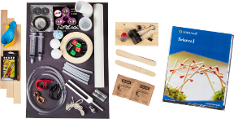Sonlight’s Science J course teaches about physics, electromagnetism, and waves. It was designed specifically for use in conjunction with Sonlight's history, Bible, and literature course titled History of Science Level J. Both of these 36-week courses can be used for eighth, ninth, or tenth grade.
Four books that come with History of Science Level J are also used with Science J. Three of those books are Joy Hakim’s The Story of Science series─Aristotle Leads the Way, Newton at the Center, and Einstein Adds a New Dimension. The fourth book, Jeanne Bendick’s Archimedes and the Door of Science, is used in one lesson. Most readings from Hakim's books are scheduled in History of Science Level J. Science J assigns additional readings from those books and relies on students to complete all of the reading assignments from both courses. Lab activities in Science J are based on scientific principles discussed in the readings from both courses.
Science J consists of a lab kit and a package of loose-leaf pages to be put into binders. The loose-leaf pages are labeled as an instructor’s guide, but they are for both the parent and the student. The pages are divided into three sections. The first section is a brief explanation of the course for the instructor, and the third section has weekly notes for parents and student activity pages with overprinted answers. Notes for parents include only a brief overview of the week’s lessons, tips regarding the experiments, and occasional notes about the activity pages. The parent does not have copies of all student pages. The second section of the instructor's guide consists of student lab pages that serve as the student workbook. You will probably want to put the student pages into a separate binder while keeping the other two sections together for the instructor.
The student pages are mostly related to the lab work. Each week’s student lab pages list the pages to be read in one of the Hakim books. Discussion questions for those readings are in the History of Science Level J instructor’s guide rather than in the Science J instructor’s guide. Two lists tell you what lab materials that will be needed for each activity. One list shows the items provided in the lab kit, and the other list has items to gather on your own, such as a ruler, a hammer, a cereal bowl, flour, and a timer. A brief overview for the student (which differs from the overview for the teacher) provides some background for the lab activity and usually makes a connection to the assigned reading material. Most weeks' lessons include additional instructional information under the heading “Deeper into the Scientific Principle.” The rest of each week’s student lab pages show step-by-step, illustrated instructions and have activity pages for students to complete. Some math is required as is appropriate for these grade levels.
The lab kit was designed specifically for this course and cannot be used on its own. A list of items that are in the kit is at the front of the instructor’s guide as well as on the Sonlight website. Examples of some of the items in the kit are aluminum foil, balloons, AA batteries, ceramic disc magnets, a diffraction grating, dowels, a fidget spinner, a hot glue gun, leads with alligator clips, round magnets, a neodymium magnet, PVC clear tubing, a syringe, a tuning fork, and copper wire. It is possible to gather all of these items on your own, but there’s a lot to be said for having the exact items they recommend and saving the time it takes to gather all of them.
Since the instructor does not have copies of all of the student lab pages, it seems clear that students are expected to work independently through most of the coursework. Notes in the parent's section alert the instructor to potential challenges students might encounter, so this makes it easier to know when supervision might be needed for some lab activities.
Summary
This integrated approach using History of Science Level J with Science J helps students make connections between history, science, and faith—more of a unit study approach than we generally find in other courses for eighth through tenth grades. I expect most students will retain information better when they learn about the relationships between topics in the different subject areas.









